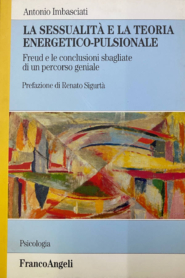
Sexuality and the Energy-and-Drive Theory. Freud and the wrong these in his genious course
The Drive Theory, that Freud formulated throughout his whole work with the aim to explain the origins and the functioning of the mind, has remained the milestone of psychoanalysis and the best known part to those who do not work in the field. Drive, repression, libido, energy and other terms have become part of the common language. Yet the Drive Theory it is the very part of Freud’s remarkable work that has been most criticized by psychoanalysts themselves, which consider it as superseded, at least in Freud’s original biological formulation. The book aims to show that this theory was formulated beginning from the first hypotheses on sexuality that Freud, as far back as the end of the nineteenth century, put forward. These hypotheses were progressively extended and transformed into an organic theory that assumed an implicit value of truth, or rather became the explanation of the entire psychic functioning. The progressive evolving of his thought are examined along the complete collection of Freud’s writings, highlighting his progressive “surmises” (guessing, according to the german word erraten used by Freud himself) with which he “invented” the theory. We maintain that inventing was useful. In every science all the theories are “invented” because of their usefulness for the progress of that science. But all the theories, in all sciences, change as that science progresses and are replaced by other more consistent ones, thus promoting the progress of that science. Today better theories than that of Freud exist in psychoanalysis.
This however does not affect the geniality of Freud’s thought in the context of sciences of his time.
The book aims to show ten theses, through an interpretation of the Freudian work that can be summarized as follows:
1. The Drive Theory (based on Metapsychology as its core) was derived by a progressively extending his first hypotheses, elaborated between 1884 and 1905 and based on his clinical observations of sexuality.
2. In the original formulation of this “psychosexual model”, Freud homogenizes the conscious experiences of sexuality (basically male sexuality) with a correspondent metabolism of “sexual substances”.
3. In this way a descriptive model of metaphoric value is gradually turned into a “strong” explanatory theory, of biological nature, along with the positivism principles of the other sciences of his time. In this transformation a reification of experience is made, through a process that can be called “hypostasis” processes.
4. The hypotheses about a metabolism of sexual substances are transformed into an explanatory theory of sexuality, which in turn is transformed into an explanatory theory of the general functioning of the mind. The transformation takes place through a reformulation of the basic concept of drive, by extending the previous concept used for sexuality.
5. Today the Drive Theory is recognized as being in contrast with the clinical practice of Freud himself and is superseded not only by the progress of psychoanalysis but also by neuroscience, particularly cognitive sciences. It cannot longer have the explanatory value that Freud wanted to attribute to it.
6. Freud had a strong explanatory intent, beside a clinical-descriptive one, to align psychoanalysis with the other sciences of the time according to the then dominating positivism spirit. With this partly political intention he called his theory the ” Metapsychology witch”.
7. The theory, although nowdays denied in its explanatory value, provides a very useful metaphor for clinical practice, confirming the heuristic value that Freud attributed to ” surmising”.
8. The theory revealed itself as being very useful in the context of scientific politics, attracting hundreds of researchers that have made psychoanalysis progress by developing different theories.
9. The real progress of psychoanalysis as a science is due to the method that has allowed clinical research, and not to the theory, which has been successful but has not benefitted its progress.
10 Freud’s thinking, although it lead to biologistic conclusions that proved groundless, was of exceptional genius at that time and revolutionized the general picture for all sciences, and psychology over all. The evolution of his thinking can still be considered as a model in terms of scientific inductive process to continue to carry out any research in psychoanalysis.
